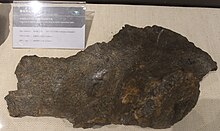
Mamenchisaurus is a genus of sauropod dinosaur known for their remarkably long necks which made up nearly half the total body length. Numerous species have been assigned to the genus; however, many of these might be questionable. Fossils have been found in the Sichuan Basin and Yunnan Province in China. Several species are from the Upper Shaximiao Formation whose geologic age is uncertain. However, evidence suggests that this be no earlier than the Oxfordian stage of the Late Jurassic. M. sinocanadorum dates to the Oxfordian stage and M. anyuensis to the Aptian stage of the Early Cretaceous around 114.4 mya. Most species were medium to large size sauropods, around 15 to 26 meters in length and possibly up to 35 meters (115 ft) based on two undescribed vertebrae.
Ultrasaurus is a genus of sauropod dinosaur discovered by Haang Mook Kim in South Korea. However, the name was first used unofficially in 1979 by Jim Jensen to describe a set of giant dinosaur bones he discovered in the United States. Because Kim published the name for his specimen before Jensen could do so officially, Jensen renamed his specimen Ultrasauros. Jensen's giant sauropod was later found to be a chimera, and the type remains are now assigned to Supersaurus.
Haplocanthosaurus is a genus of intermediate sauropod dinosaur. Two species, H. delfsi and H. priscus, are known from incomplete fossil skeletons. It lived during the late Jurassic period, 155 to 152 million years ago. The type species is H. priscus, and the referred species H. delfsi was discovered by a young college student named Edwin Delfs in Colorado, United States. Haplocanthosaurus specimens have been found in the very lowest layer of the Morrison Formation, along with Hesperosaurus mjosi, Brontosaurus yahnahpin, and Allosaurus jimmadseni.

Opisthocoelicaudia is a genus of sauropod dinosaur of the Late Cretaceous Period discovered in the Gobi Desert of Mongolia. The type species is Opisthocoelicaudia skarzynskii. A well-preserved skeleton lacking only the head and neck was unearthed in 1965 by Polish and Mongolian scientists, making Opisthocoelicaudia one of the best known sauropods from the Late Cretaceous. Tooth marks on this skeleton indicate that large carnivorous dinosaurs had fed on the carcass and possibly had carried away the now-missing parts. To date, only two additional, much less complete specimens are known, including part of a shoulder and a fragmentary tail. A relatively small sauropod, Opisthocoelicaudia measured about 11.4–13 m (37–43 ft) in length. Like other sauropods, it would have been characterised by a small head sitting on a very long neck and a barrel shaped trunk carried by four column-like legs. The name Opisthocoelicaudia means "posterior cavity tail", alluding to the unusual, opisthocoel condition of the anterior tail vertebrae that were concave on their posterior sides. This and other skeletal features lead researchers to propose that Opisthocoelicaudia was able to rear on its hindlegs.

Euhelopus is a genus of sauropod dinosaur that lived between 145 and 133 million years ago during the Berriasian and Valanginian stages of the Early Cretaceous in what is now Shandong Province in China. It was a large quadrupedal herbivore. Unlike most other sauropods, Euhelopus had longer forelegs than hind legs. This discovery was paleontologically significant because it represented the first dinosaur scientifically investigated from China: seen in 1913, rediscovered in 1922, and excavated in 1923 and studied by T'an during the same year. Unlike most sauropod specimens, it has a relatively complete skull.
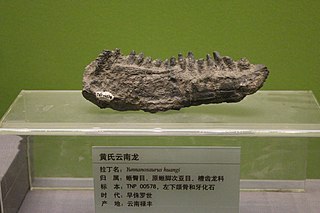
Yunnanosaurus is an extinct genus of sauropodomorph dinosaur that lived approximately 199 to 183 million years ago in what is now the Yunnan Province, in China, for which it was named. Yunnanosaurus was a large sized, moderately-built, ground-dwelling, quadrupedal herbivore, that could also walk bipedally, and ranged in size from 7 meters (23 feet) long and 2 m (6.5 ft) high to 4 m (13 ft) high in the largest species.
Zigongosaurus is a genus of sauropod dinosaur from the Middle Jurassic-Late Jurassic-age Shaximiao Formation of Zigong, Sichuan, China. Because of incomplete knowledge of Jurassic Chinese sauropods, it has been hard to interpret, with some sources assigning it to Omeisaurus, some to Mamenchisaurus, and some to its own genus.
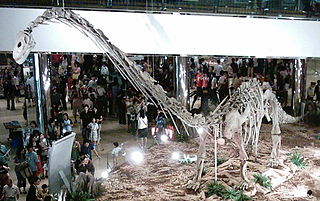
Omeisaurus is a genus of sauropod dinosaur from the Middle Jurassic Period of what is now China. Its name comes from Mount Emei, where it was discovered in the lower Shaximiao Formation of Sichuan Province.

Klamelisaurus is a genus of herbivorous sauropod dinosaur from the Middle Jurassic Shishugou Formation of China. The type species is Klamelisaurus gobiensis, which was named by Zhao Xijin in 1993, based on a partial skeleton discovered in 1982 near the abandoned town of Jiangjunmiao. Zhao described Klamelisaurus as the only member of a new subfamily, Klamelisaurinae, among the now-defunct primitive sauropod order Bothrosauropodoidea. Since Zhao's description, Klamelisaurus received limited attention from researchers until Andrew Moore and colleagues redescribed it in 2020.

Patagosaurus is an extinct genus of eusauropod dinosaur from the Middle-Late Toarcian of Patagonia, Argentina. It was first found in deposits of the Cañadón Asfalto Formation, which date to around 179 to 177 million years ago. Although originally twelve specimens were assigned to the taxon, at least one of them may belong to a different genus. Patagosaurus probably lived alongside genera as Piatnitzkysaurus, Condorraptor and Volkheimeria.
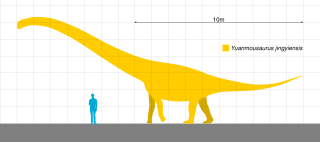
Yuanmousaurus was a sauropod dinosaur from the Middle Jurassic period of China. It is known from incomplete remains, recovered in 2000 from the Zhanghe Formation in Yuanmou County in Yunnan Province. Yuanmousaurus was a relatively large sauropod and may have reached about 17 meters (56 ft) in length. It was a basal member of the Sauropoda, but its exact systematic position is unclear. A recent study placed Yuanmousaurus within the family Mamenchisauridae. The only and type species was Yuanmousaurus jiangyiensis.

Phuwiangosaurus is a genus of titanosaur dinosaur from the Early Cretaceous (Valanginian-Hauterivian) Sao Khua Formation of Thailand. The type species, P. sirindhornae, was described by Martin, Buffetaut, and Suteethorn in a 1993 press release and was formally named in 1994. The species was named to honor Princess Maha Chakri Sirindhorn of Thailand, who was interested in the geology and palaeontology of Thailand, while the genus was named after the Phu Wiang area, where the fossil was discovered.

Euhelopodidae is a family of sauropod dinosaurs of disputed membership and affinities, which contains Euhelopus and its close relatives. Most proposed euhelopodids are from East Asia.
Camarasauridae is a family of sauropod dinosaurs. Among sauropods, camarasaurids are small to medium-sized, with relatively short necks. They are visually identifiable by a short skull with large nares, and broad, spatulate teeth filling a thick jaw. Based on cervical vertebrae and cervical rib biomechanics, camarasaurids most likely moved their necks in a vertical, rather than horizontal, sweeping motion, in contrast to most diplodocids.
The Meng-Yin or Mengyin Formation is a geological formation in Shandong, China, whose strata date back to the Berriasian and Valanginian stages of the Early Cretaceous.

Daxiatitan is a genus of sauropod dinosaur known from the Lower Cretaceous of Gansu, China. Its type and only species is Daxiatitan binglingi. It is known from a single partial skeleton consisting of most of the neck and back vertebrae, two tail vertebrae, a shoulder blade, and a thigh bone. At the time of its discovery in 2008, Daxiatitan was regarded as potentially the largest known dinosaur from China.
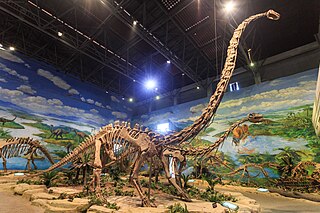
Mamenchisauridae is a family of sauropod dinosaurs belonging to Eusauropoda known from the Jurassic and Early Cretaceous of Asia and Africa. Some members of the group reached gigantic sizes, amongst the largest of all sauropods.

Sibirotitan is a genus of somphospondyl sauropod from the Ilek Formation of Russia. The type and only species is S. astrosacralis.
